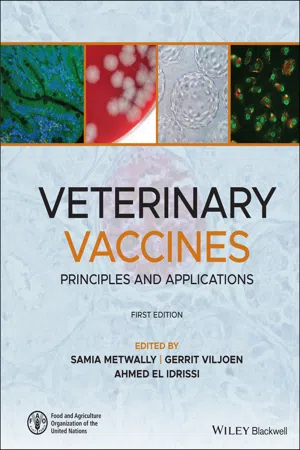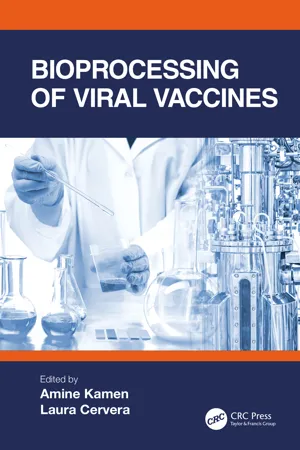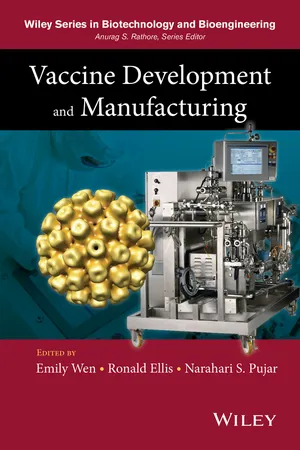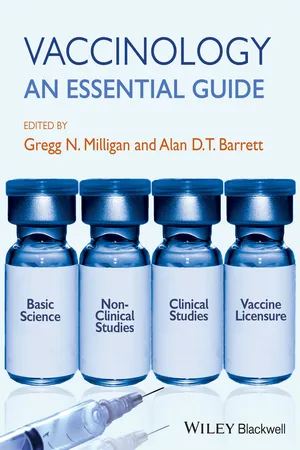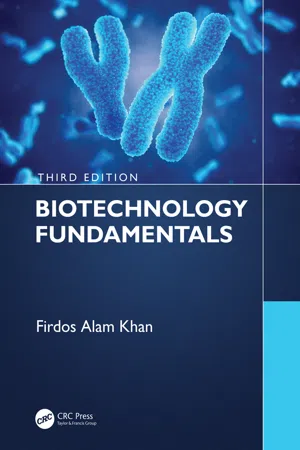Biological Sciences
Vaccine Manufacturing
Vaccine manufacturing involves the production of vaccines, which are biological preparations that provide immunity against specific diseases. The process typically includes growing the disease-causing organism, inactivating or attenuating it, and formulating it into a vaccine. Quality control and regulatory compliance are crucial aspects of vaccine manufacturing to ensure safety and efficacy.
Written by Perlego with AI-assistance
Related key terms
5 Key excerpts on "Vaccine Manufacturing"
- eBook - ePub
Veterinary Vaccines
Principles and Applications
- Samia Metwally, Gerrit Viljoen, Ahmed El Idrissi, Samia Metwally, Gerrit Viljoen, Ahmed El Idrissi(Authors)
- 2021(Publication Date)
- Wiley-Blackwell(Publisher)
Section III Aspects of Vaccine Production, Quality Control, and DistributionPassage contains an image
11 The Manufacture of Veterinary Vaccines: Manufacturing FacilitiesTeresa Yeary, Renee Schnurr, Richard Hill Jr., Mark Pagala, and Douglas MurtleUSDA‐APHIS‐VS‐DB‐Center for Veterinary Biologics, Ames, Iowa, USA11.1 Introduction
The design of manufacturing facilities for veterinary vaccines is guided by the types of vaccines that will be manufactured in them. Essential to the facility design are the types of organisms, antigens or nucleic acids used in the vaccine, the specific technologies and manufacturing processes employed, and the regulatory requirements of the manufacturing facility's locale and the countries where the vaccine will be marketed. Key aspects of production that assure a high‐quality finished product are qualification of incoming ingredients and materials, qualified personnel, controlled processes in an appropriate manufacturing facility, proven technology and manufacturing procedures, validated equipment, in‐process validation and controls, and testing (Halkjær‐Knudsen 2007 ). Facilities should be designed so that personnel and the environment are protected from harm and the product prepared is protected from the environment. The ultimate design objective is to prepare a pure, safe, potent, and efficacious vaccine product in a facility that is maintained and operated in compliance with all local laws, rules, and regulations of the regulatory authority responsible for the oversight of biologics production (United States Code (USC ) 1985 ; Code of Federal Regulations (CFR ) 2020a ; USDA Veterinary Services Memorandum 2020 ).11.2 Vaccine Production Systems – General Design and Operating Requirements
11.2.1 Facility Arrangement and Construction
Facility design for a manufacturing and testing facility is dependent on the methods of manufacture employed to produce the class of biological products prepared within it, e.g. bacterins or vaccines (live, attenuated, or inactivated), toxoids, subunit virus‐like particles, allergens, recombinant DNA, immunoglobulins, immunomodulators, in vitro - eBook - ePub
- Amine Kamen, Laura Cervera(Authors)
- 2022(Publication Date)
- CRC Press(Publisher)
Phase 4 occurs after the vaccine has been approved for use and is incorporated into immunization surveillance programs. This is also known as post-marketing surveillance. This includes ongoing safety monitoring, assessing vaccine effectiveness in specific population groups, and determining the duration of immunity to inform future decisions on the need for booster doses.As it is the case for any biologics, any significant change in the Vaccine Manufacturing process might require clinical demonstrations of safety and eventually efficacy. Manufacturing of vaccines on different sites or countries might require bridging clinical trials. The role of the WHO through “pre-qualification” of Vaccine Manufacturing sites worldwide is an improved process for facilitating commercialization of vaccines in the different regions of the world.1.5 Basic Principles of Viral Vaccine Design and Traditional ProductionThis textbook focuses only on viral vaccines; therefore, although designed using the same principles to activate immune response, other microbial infections and vaccination strategies will not be discussed. Vaccines might be classified taking into consideration their design and mode of exposure of the dominant antigen to the human immune system.Figure 1.1 captures the principles of vaccination and provides a simplified view of the possible interaction pathways with key mediators of the immune response. This section will be detailed in Chapter 3 of this textbook by reviewing the basic principles in immunology that are directly applicable to vaccine design and development.Figure 1.1Description of the different types of vaccines and their possible interaction with the immune system. Credit for the design: Kumar Subramaniam.Traditional viral vaccines involve the whole virus as inactivated or live attenuated, such as influenza vaccines (Chapter 9 ), or a sub-unit, representing the dominant antigen extracted from the viral structure, such as Hepatitis B vaccines. Recombinant DNA technology enabled the design of vectored vaccines (Chapter 11 ) such as adeno-vectored vaccines against Ebola, SARS-CoV-2 infections, virus like-particle vaccines (Chapter 10 ) such as human papilloma virus vaccine, and recombinant protein vaccines such as recombinant hemagglutinin as the first approved influenza vaccine of its kind. An emerging class of vaccines based on delivery of genomic components of the virus include DNA vaccines and mRNA vaccines (Chapter 12 ). Over the COVID-19 pandemic, a remarkable demonstration has been made on safety, efficacy, and effectiveness of mRNA vaccines against SARS-CoV-2 infection, establishing this vaccine technology platform as a major technological jump in vaccinology. As data collected for phase 4 following the vaccine approval and commercialization of COVID-19 mRNA - eBook - ePub
- Emily P. Wen, Ronald Ellis, Narahari S. Pujar, Emily P. Wen, Ronald Ellis, Narahari S. Pujar(Authors)
- 2014(Publication Date)
- Wiley(Publisher)
When evaluating manufacturing cost, one must also consider decisions within the context of the global project timeline, as risk and delays can often have a greater impact on the economic viability of a product than the absolute costs themselves. This chapter reviews the interplay between these elements and outlines the techniques often used to evaluate the cost implications of manufacturing decisions. Case studies are also presented to demonstrate these techniques in actual practice.15.2 Vaccine Manufacturing, History, and Drivers
The history of vaccines dates back over 200 years ago to the development of a smallpox vaccine by Edward Jenner in 1798. Developments in vaccination have advanced sufficiently to protect humans and animals from most life-threatening diseases, with large focus applied to these preventative steps during the 1930s, the 1970s, and again today. The invention of antibiotics took the focus away from vaccines during the Second World War, and it was not returned until 1970, when research was revived. The mapping of the human genome coupled with advancements in the understanding of molecular genetics has brought about new interest and techniques for discovery. Today's challenges lie with the prevention of cancer, HIV, and hepatitis. There are two broad types of vaccine used today, each with their own cost structure.15.2.1 Traditional
- Attenuated—the virulent organism is weakened by unnatural host conditions or special modification, with the resultant effect of a scaled down immune response.
- Inactivated—the virus is treated with an agent that destroys its replicative function.
- Hepatitis B plasma derived—the first cancer vaccination was derived from the blood serum of a patient with hepatitis B. The sample was purified and attached to an alum adjuvant, resulting in a safe and effective entity. However, the complex downstream processing and concerns over the safety of human blood serums meant that this solution was only short-lived.
15.2.2 Modern
These vaccines have been developed following developments in molecular genetics and are based on modern processes manufactured in state-of-the-art facilities. They differ from traditional vaccines in that they are highly purified and well characterized. - eBook - ePub
Vaccinology
An Essential Guide
- Gregg N. Milligan, Alan D. T. Barrett, Gregg N. Milligan, Alan D. T. Barrett(Authors)
- 2014(Publication Date)
- Wiley-Blackwell(Publisher)
de novo at the bench and moved into clinical practice, but rather to illustrate how developments and findings from many aspects of biology are contributing to the development of vaccinology, an overarching discipline that encompasses immunology, molecular and cell biology, computational biology, toxicology, virology and microbiology, neuroscience, oncology, materials sciences and chemistry, and many others. As an increasing number of scientific fields are becoming more multidisciplinary, vaccinology is becomingly ever more dependent on developments in other areas of research as we move away from the “identify, inactivate, inject” paradigm.The basic science techniques used for vaccine development are those used in every other biological discipline that can have an application to vaccine development. From tools such as high-throughput, whole-genome sequencing to the cell biology of signaling downstream of immunological pattern recognition receptors, the numerous advances in technology for basic science have facilitated the development of numerous and novel vaccine candidates. However, there remains a bottleneck in transitioning these bench advances to the clinical setting. In part, this is due to regulators expecting advanced scientific tools to be used for quality control of vaccines to improve their characteristics. For example, improved technology has enabled scientists to improve the level of detection of DNA from 1 nanogram (10−9 g) to 1 picogram (10−12 g) such that regulators now expect DNA contamination of vaccines to be less than 1 picogram. Translational science is a recent trend in research design, which aims to facilitate the transition of breakthroughs at the bench to the clinic.Perhaps the advance that has most benefited vaccinology is the use of molecular biology techniques. These fundamental methods, developed in the 1970s, have driven the development of recombinant and subunit vaccines, allowing the production of vaccines for pathogens that cannot be grown for inactivation or attenuation by traditional methods. The first subunit recombinant vaccine was for hepatitis B, where hepatitis B surface antigen (HBsAg) was expressed in yeast and replaced hepatitis B particles that were purified from the plasma of infected individuals as the commercial vaccine. - eBook - ePub
- Firdos Alam Khan(Author)
- 2020(Publication Date)
- CRC Press(Publisher)
9 Medical Biotechnology LEARNING OBJECTIVES Explain the role of biotechnology in medicine Discuss how vaccines are manufactured and explain the related issues Discuss the process of making antibodies and hybridoma technology Explain the significance of therapeutic protein and its production Discuss the success and failure of gene therapy and organ transplantation Discuss tools and techniques used in medical biotechnology 9.1 INTRODUCTION Biotechnology has many applications in medicine. While dealing with diseases, biotechnology tools and techniques have been used in the prevention, diagnosis, and cure of diseases. Through human genetics, biotechnology has found use in genetic counseling, antenatal diagnosis, and gene therapy. In forensic medicine, it has already been used for identification of individuals who could be criminals. The major applications include animal and human healthcare, genetic counseling, and forensic medicine. Biotechnology is useful in providing immunity against a disease through the development of a vaccine and in the diagnosis of a disease at an early stage of its onset. Table 9.1 shows a list of the various applications of medical biotechnology. 9.2 VACCINES A vaccine is a biological preparation that improves immunity to a specific disease. It typically contains an agent that resembles a disease-causing microorganism and is often made from weakened or killed forms of the microbe. The agent stimulates the body’s immune system to recognize the agent as foreign, destroy it, and “remember” it so that the immune system can more easily recognize and destroy any of these microorganisms that it later encounters. Sometime during the 1770s, Edward Jenner heard a milkmaid boast that she would never have the often-fatal or disfiguring disease smallpox because she had already had cowpox, which has a very mild effect in humans
Index pages curate the most relevant extracts from our library of academic textbooks. They’ve been created using an in-house natural language model (NLM), each adding context and meaning to key research topics.
